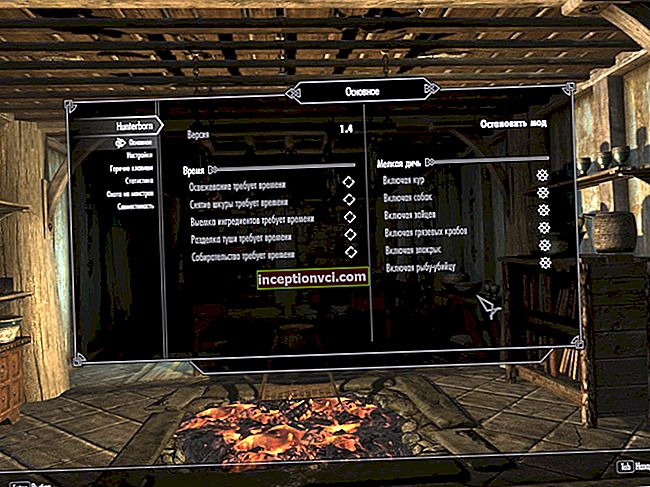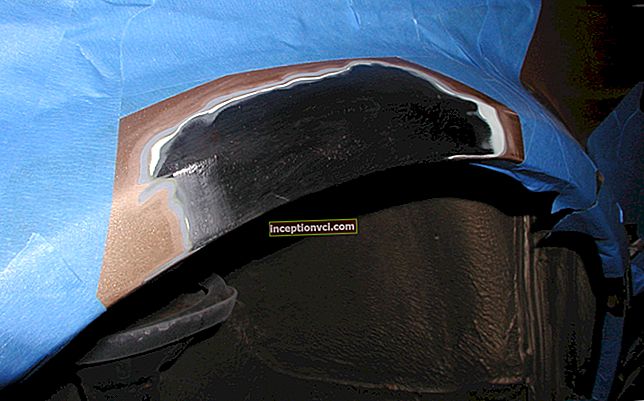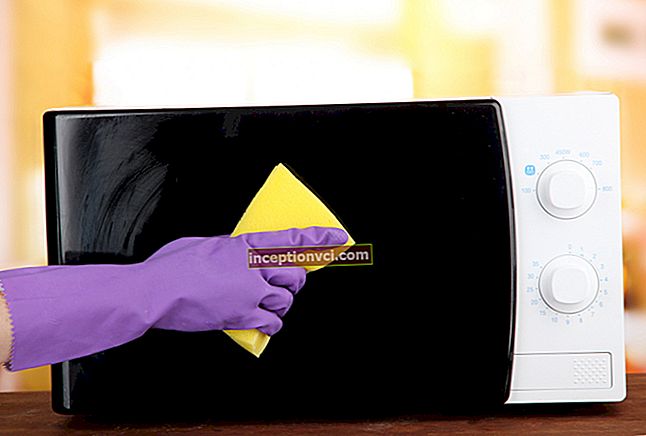HDTV receiver Galaxy Innovations GI ST9196 has two receiving paths - satellite and terrestrial, which makes it possible to receive MPEG-2 and MPEG-4 broadcasts in DVB-S / S2 and DVB-T standards. This device meets all modern requirements for a universal terminal, because:
1) can be used to view standard and high definition programs;
2) has an impressive set of interfaces for connecting external devices;
3) has software and hardware support for viewing paid channels;
4) Supports PVR functions for viewing and organizing multimedia data.
Design

The Galaxy Innovations GI ST9196 terminal has a medium-sized black case and looks quite stylish. The following controls are located on the front panel of the receiver:
- - Power button for switching on the working / standby mode;
- - "navigation circle", traditionally used as the main control element of the remote control. It consists of dual-purpose buttons: to change the position of the cursor in the OSD display mode or to alternate between channels and control the volume level. The OK selection confirmation button, located in the center of the "navigation circle", has a blue backlight;
- - Button to call the OSD Menu.
Behind the tinted glass of the front panel is a matrix vacuum luminescent display (VFD) with green backlight. Depending on the flow status, the screen displays:
- - number and name of the channel that is included;
- - the name of the sections of the setup menu;
- - the name of the video or audio file being played;
- - current time.
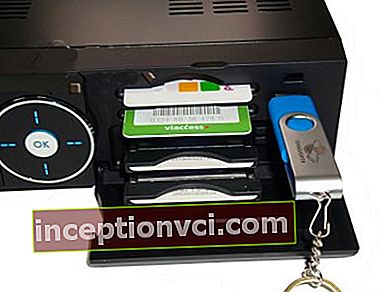
Behind the hinged cover there are slots for two smart card readers, two slots for installing CI modules and a USB port connector.

There are interface connectors on the rear panel of the device:
- - input for connecting a satellite dish LNB IN and loop output LNB OUT (F-type sockets);
- - an input for connecting an antenna used to receive digital terrestrial television ANT IN, and a loop output LOOP OUT (IEC 169-2 jacks);
- - two EuroScart connectors (TV, VCR);
- - outputs of the YUV-interface of the component video signal (RCA-type jacks);
- - audio R / L and composite video VIDEO outputs (RCA-type jacks);
- - HDMI digital video / audio output;
- - optical (Toslink) digital audio output S / PDIF;
- - e-SATA connector for connecting an external hard drive;
- - Ethernet LAN interface connector;
- - socket for connecting the antenna of the adapter for wireless connection of Wi-Fi to the local network. A foldable Wi-Fi antenna is included with the receiver.
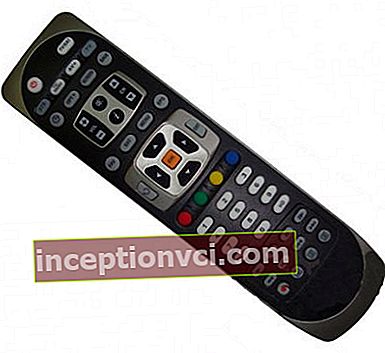
The GI ST9196 receiver is equipped with a universal programmable remote control, which can also be used to control your TV. In the "User's Guide" there are code tables, using which the remote control can be easily reconfigured to control TVs of different models. The sending of a command by the remote control is duplicated by the illumination of the one of the buttons, which switches the remote control to the control mode of the current device (TV / STB). Despite its impressive dimensions, the IR remote control fits comfortably in the hand. When placing the keyboard buttons, the ergonomic features of the shape of the control panel body and the principle of grouping in accordance with the functional purpose of individual buttons are taken into account.
Menu settings
The tested device has an intuitive setup system and a friendly user interface. The receiver control menu is characterized by high-speed operation and high-quality graphics. True, the OSD has standard definition graphics, which, in principle, is not a drawback of the device, but, on the contrary, contributes to better "readability" of the menu on a small screen.
A flexible system of receiver settings provides:
- multilingual language support.The software supports a choice of preferences from 17 OSD languages, 20 audio track languages and 16 subtitle languages. All preference lists include Russian. The translation into Russian is quite correct. Some "roughness" of the translation is likely to be corrected by the manufacturer in the next software versions; the ability to select video parameters of the image. PAL or NTSC composite video color systems are supported. The analog video signal can also be captured from the SCART output in RGB format or from component bells (YUV). Simultaneous use of RGB signal and YUV output is not provided. From the HDMI digital output, the signal can be supplied using the resolutions 576p, 720p, 1080i. The YUV output is available in standard and high definition formats. This fact will undoubtedly please those users who have TVs with limited HDTV video signal connection capabilities. The video processor of the GI ST9196 terminal supports the function of enhancing images in interlaced decomposition format (deinterlacing function). This function can be useful when watching standard definition video on a large screen when connected using the component YUV output; the ability to select the optimal display format when watching programs broadcasted in 4: 3 and 16: 9 formats; control of the color parameters of the image. The software allows the use of four viewing color schemes (Movie, News, Sports, User Mode). The color scheme is characterized by a combination of three user settings (brightness, contrast, saturation); selection of the volume control mode. The actions for adjusting the audio level can be saved for each channel separately or be common for all viewed channels; change of display modes. The options for choosing the display time and transparency of the OSD menu are supported. There is a function to control the brightness of the luminescent display of the front panel (10 steps); the ability to use manual or automatic synchronization of the system clock. Supports 24- and 12-hour current time display formats; control of access to the setup menu and viewing channels. The software provides the ability to separately set permissions for access to the setup menu and blocking channels. For additional protection "from children" can be used the option to programmatically disable the front panel control buttons; saving the current memory configuration to ensure stable operation. This function allows you to create and, if necessary, then return to the set "point of return". Thus, it is possible to reduce the efforts to restore the user configuration (menu settings, viewing, channel base, position of the motorized antenna) in a situation where, for some reason (unskilled user actions, software failure), this data was lost.
Channel search
The Galaxy Innovations GI ST9196 receiver software allows the use of various types of satellite receiving antenna systems and search modes. Distinctive features of the tested device as a satellite digital receiver:
- - the ability to connect fixed antennas switched by a DiSEqC switch. The use of DiSEqC 1.0 and DiSEqC 1.1 protocols is supported;
- - support for the use of motorized antennas controlled by DiSEqC 1.2 or USALS-positioner. The software allows the use of mixed receiving systems (fixed and motorized). For testing, we used a receiving system of two antennas: fixed and motorized (polar suspension + DiSEqC-1.2 positioner). Switching between them was carried out using a DiSEqC switch.When checking this mode, one detail became clear: switching between channels received from a fixed and motorized antenna occurs correctly if they are carried out between the lists of services of a fixed antenna and satellite channels related to the current coordinate of the polar suspension (that is, to which the positioner is already tuned). If the channel selected from the list of services belonged to the satellite to which the positioner should "turn" the antenna, then when switching to it from the channel belonging to the list of services received from the fixed antenna, the DiSEqC positioner did not execute the command to switch to another satellite. To make such a transition, it was necessary to first turn on for viewing the channel related to the list of services received from the already installed position of the motorized antenna, and then switch to the channel related to another satellite received by the motorized antenna;
- - the ability to control the supply voltage levels of the receiving system (13/18 or 14/19 Volts), as well as the option to turn off the LNB power via OSD;
- - An impressive list of pre-installed satellites, including the names of 155 satellites for positions from 180 ° E. to 61 ° W There is a possibility of expanding this list at the expense of satellites, the parameters of which are set by the user (additional 10 new satellites). To adjust the motorized antenna, an interval (continuous) or step-by-step mode of moving it can be used;
- - Support for all possible types of channel search: automatic (by preset transponders of one or several satellites), manual, detailed (with PID indication) and full ("blind") search. In each of the modes, one or more selected satellites can be searched for. In the detailed search mode, you can additionally use the option to search for channels with standard definition or HD format. The terminal has demonstrated reliable operation in the process of detecting and receiving digital satellite packets, which are broadcast at various symbol rates (from 1.5 to 44.948 Msps);
- - the receiver quickly searches for channels in automatic mode. The search time for channels from the Hot Bird satellite, 13 ° East, was about 5 minutes (1410 TV channels and 383 radio channels were found). In the “blind” search for transponders on the same satellite, the search process took about 10 minutes (1515 TV channels and 413 radio channels were found). In the search mode, the display shows the names of the channels found, the number of new ones, and the transponder parameters. In automatic mode, the progress of the search is also indicated. Channels whose names contain Cyrillic characters are displayed on the screen correctly in the search and view modes. Tests have shown that with a "blind" search, the receiver successfully detects DVB-S / QPSK and DVB-S2 / 8PSK broadcasts;
- - network search mode is supported. During testing, it was found that the use of this function leads in some cases to unexpected consequences. The receiver can repeatedly search for packets related to a certain network, and each time it "appends" the re-found channels as newly discovered services to the current list of channels. Thus, several “duplicates” of channels found during scanning are formed in the user list.
- - in the manual search mode, the user can resort to the so-called "fine tuning" of the parameters of the receiving path. In this mode, it is possible to change the AGC depth and bandwidth of the high-frequency part of the receiver. Experiments have shown that the use of the "fine tuning" function gives a noticeable effect when receiving broadcasts with a low, almost close to the threshold, signal-to-noise ratio and a low symbol rate (from 1 to 3 Msps). Indeed, in this case it is possible to select such a combination of values of the NPP parameters and the "frequency band", at which the image defects associated with a low level of the received signal ("scattering" and "deceleration") become less noticeable;
- - there is a mode of "fast scanning" of channels of one of the proposed satellite networks (Canal Digitaal, TV Vlaanderen, Telesat). Perhaps this function will be of interest to users who receive programs from these paid packages broadcast from the Astra satellite, 19 ° E.
The GI ST9196 receiver allows you to search for digital terrestrial television programs in automatic and manual modes. Distinctive features of this mode of operation:
- - to search for channels in automatic mode, you do not need to enter broadcasting parameters and the type of modulation of digital carriers. The receiver scans along a preset frequency grid. In the tested version of the software, this grid corresponds to the European one in the MW and UHF bands. In the MV range (channels E5-E12), the bandwidth of the frequency channel corresponds to 7 MHz. Since the channel width in the frequency plan of the OIRT MV range corresponds to 8 MHz, the automatic search for DVB-T broadcast channels in this frequency range for our region cannot be required. With the search for channels in the UHF range, such problems, most likely, will not arise;
- - manual search for digital terrestrial channels can be carried out both by the frequency selected from the number of preset values, and by the carrier, the value of which is entered by the user.
During testing, a DecTek DTA-115 universal modulator board installed in a computer was used as a DVB-T signal source. At hand were recordings of various transport streams MPEG-2 and MPEG-4 software packages with standard definition and high definition. There were no problems when searching for broadcasts with various combinations of digital carrier modulation parameters, and there were no noticeable picture distortions during viewing. The delay of switching between channels is approximately 2-3 s. The delay before the start of playback of the encoded HDTV channel is 4-5 seconds.
Conditional access
You can view encoded channels in the Galaxy Innovations GI ST9196 terminal using the built-in universal decoder and external CAM modules.
Built-in decoder supports CAS Conax smart cards. The work of the built-in decoder and CI-interface was tested in the paid packages view mode:
- standard video resolution: NTV-Plus (Eutelsat W4, 36 ° E), Tricolor TV (Eutelsat W4, 36 ° E), Viva TV (ExpressAM2, 80 ° E) e) and "Platform DV" (Eurobird 9A, 9 ° E);
- High definition television: "HD Platform" (Eurobird 9A, 9 ° E), Penthouse HD (Eurobird 9 A, 9 ° E) and Hello HD (Eurobird 9A, 9 ° E).
In the experiments, we used various types of CAM modules at our disposal. To be honest, the test results were unexpected. Until now, we have never encountered a device with such a well-debugged conditional access system. Some shortcomings in the operation of the conditional access system can be considered practically insignificant and do not affect the overall assessment of the device. These include, for example, the unstable joint operation of two simultaneously installed DRE Crypt NP4 CAM and Penthouse CAM. This "sweet couple" only works under certain conditions. Penthouse CAM is installed in the upper CI slot, DRE Crypt NP4 CAM - in the lower one. And you need to initialize them one by one, "hot" - first Penthouse CAM, then DRE Crypt NP4 CAM. Probably, this problem will be fixed by the manufacturer of the receiver in the next software versions. General impression from the operation of the conditional access system: stable operation of the receiver when watching paid channels with standard image resolution and high definition programs.
Service functions
The software presented for testing the receiver supports the required list of viewing functions:
- information services;
- services for organizing channel lists;
- event reservation service.
Viewing functions are provided by the prompt information service (info-banner) and services: electronic program schedule (EPG), teletext, subtitles, selection of an alternative video or audio track of the program.The info banner contains the necessary reference data about the channel: name, channel type, presence of additional services, a sign of broadcast in high definition format, the presence of an AC-3 audio track, type of conditional access system, information about the current program. The info banner displays the values of the technical parameters of the broadcast: the level and quality of the signal (in conventional units), the frequency of settings, the parameters of the digital stream. In the additional window of the info banner, detailed information about the current program is displayed. Text information containing Cyrillic characters is displayed correctly.
PVR functions
Three different recorders can be connected to the Galaxy Innovations GI ST9196 receiver simultaneously:
- two USB 2.0 drives. USB flash memory or USB hard drive connect to the input on the front panel or to the connector located on the rear panel;
- external hard drive with SATA interface. The hard drive must be powered from an external source, since the receiver's own block cannot provide it with power.
Two drives can be active in the system at the same time. One of them is used to record the selected program, the other is used for delayed viewing (TimeShift). The media can be formatted directly in the receiver. The function of safely removing the USB device is supported.
The receiver allows you to:
- make "instant" recording of several services at the same time.
- to carry out "delayed" viewing (TimeShift mode). The duration of the recording by TimeShift can be changed by the user. The maximum time allotted for the TimeShift mode is 24 hours
- play the previously recorded program at normal speed, at accelerated (x2, x4, x8, x16, x32 and x64) or slowed down (x1 / 2, x1 / 4, x 1/8) tempo.
The receiver allows you to play music (MP3) and graphic (JPG) files located on the connected media. An interesting feature discovered during the testing of the device is the ability to simultaneously play MP3 music and display a slide show.
Software update and network interface
The Galaxy Innovations GI ST9196 receiver supports software update via USB. For this, the program code must be previously written into the USB flash memory module. To install the software, open the file manager window and select the “Software” tab. The window will display a list of system files (user databases, files of the main software of the receiver) located on the selected USB drive. Having selected the desired file, you need to launch it in the same way that a media file is launched for playing by the built-in player. The network interface of the device under test allows it to be connected as a host to wired and wireless networks. The device contains Ethernet and Wi-Fi adapters. A different network configuration can be selected for each type of connection. The network configuration parameters (IP and MAC addresses of the device, gateway and DNS server addresses) can be manually set by the user. For Wi-Fi connection, the mode of open and encrypted access to the network is supported. The device can work in static addressing mode or use DHCP. The built-in Ping function can be used to test communication with a network device.





